Financial Management & Decisions: An Analysis of Sainsbury Plc
VerifiedAdded on 2023/04/05
|12
|2373
|365
Report
AI Summary
This report provides a comprehensive analysis of Sainsbury Plc's financial resource management and decision-making processes. It examines various financing sources available to the enterprise, assesses the implications of these sources, and evaluates their suitability for Sainsbury's specific projects. The report also delves into the cost of identified finance sources, the significance of financial planning, and the information needed to make informed financing decisions. Furthermore, it explores the influence of financing sources on financial statements, including the income statement and balance sheet. The analysis includes a projected cash budget, computation of unit costs and prices, and an assessment of investment appraisal techniques like NPV and IRR. Finally, the report compares different financial statements and assesses Sainsbury Plc's business performance using key financial ratios, providing valuable insights into the company's financial health and strategic decision-making.
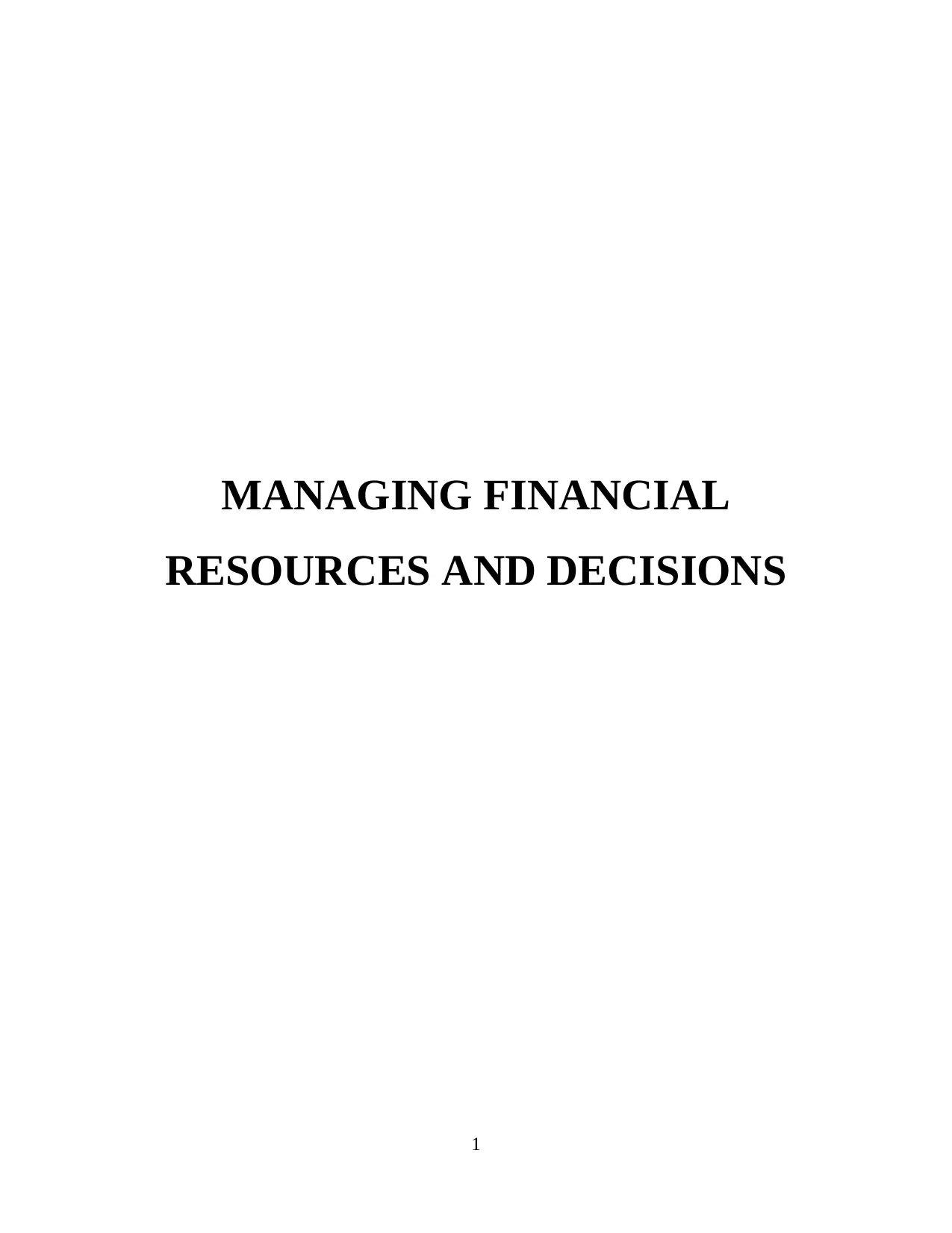
MANAGING FINANCIAL
RESOURCES AND DECISIONS
1
RESOURCES AND DECISIONS
1
Paraphrase This Document
Need a fresh take? Get an instant paraphrase of this document with our AI Paraphraser
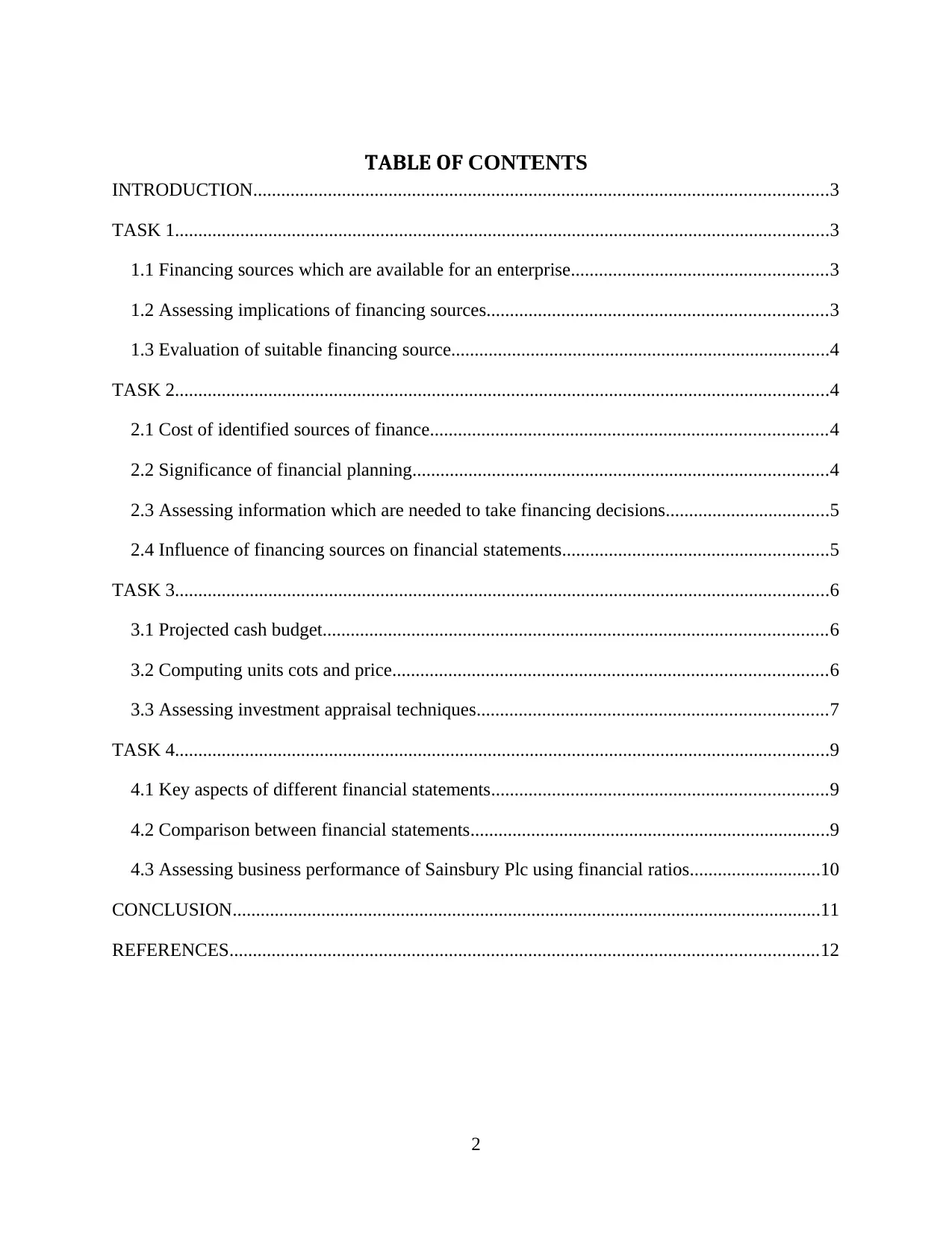
TABLE OF CONTENTS
INTRODUCTION...........................................................................................................................3
TASK 1............................................................................................................................................3
1.1 Financing sources which are available for an enterprise.......................................................3
1.2 Assessing implications of financing sources.........................................................................3
1.3 Evaluation of suitable financing source.................................................................................4
TASK 2............................................................................................................................................4
2.1 Cost of identified sources of finance.....................................................................................4
2.2 Significance of financial planning.........................................................................................4
2.3 Assessing information which are needed to take financing decisions...................................5
2.4 Influence of financing sources on financial statements.........................................................5
TASK 3............................................................................................................................................6
3.1 Projected cash budget............................................................................................................6
3.2 Computing units cots and price.............................................................................................6
3.3 Assessing investment appraisal techniques...........................................................................7
TASK 4............................................................................................................................................9
4.1 Key aspects of different financial statements........................................................................9
4.2 Comparison between financial statements.............................................................................9
4.3 Assessing business performance of Sainsbury Plc using financial ratios............................10
CONCLUSION..............................................................................................................................11
REFERENCES..............................................................................................................................12
2
INTRODUCTION...........................................................................................................................3
TASK 1............................................................................................................................................3
1.1 Financing sources which are available for an enterprise.......................................................3
1.2 Assessing implications of financing sources.........................................................................3
1.3 Evaluation of suitable financing source.................................................................................4
TASK 2............................................................................................................................................4
2.1 Cost of identified sources of finance.....................................................................................4
2.2 Significance of financial planning.........................................................................................4
2.3 Assessing information which are needed to take financing decisions...................................5
2.4 Influence of financing sources on financial statements.........................................................5
TASK 3............................................................................................................................................6
3.1 Projected cash budget............................................................................................................6
3.2 Computing units cots and price.............................................................................................6
3.3 Assessing investment appraisal techniques...........................................................................7
TASK 4............................................................................................................................................9
4.1 Key aspects of different financial statements........................................................................9
4.2 Comparison between financial statements.............................................................................9
4.3 Assessing business performance of Sainsbury Plc using financial ratios............................10
CONCLUSION..............................................................................................................................11
REFERENCES..............................................................................................................................12
2
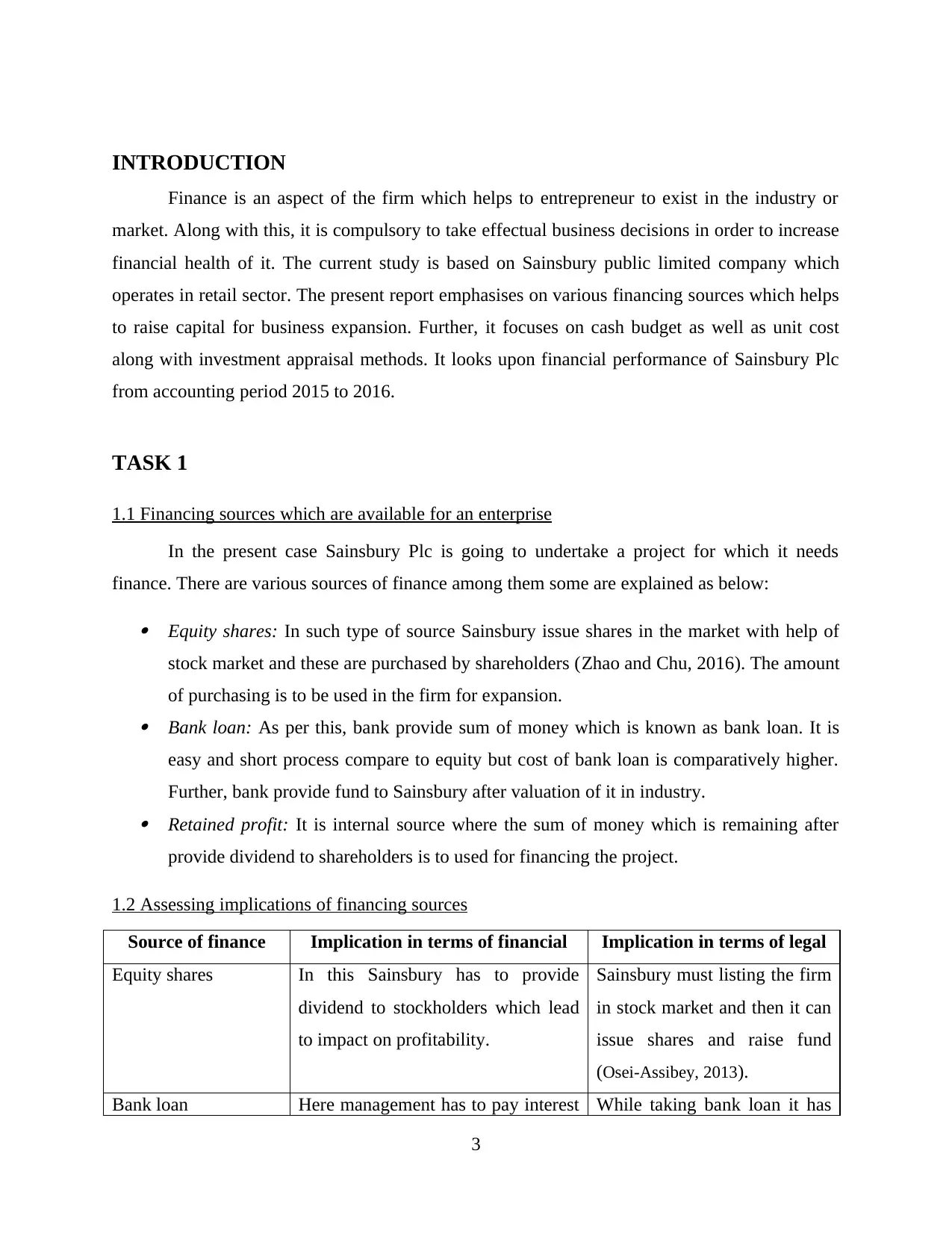
INTRODUCTION
Finance is an aspect of the firm which helps to entrepreneur to exist in the industry or
market. Along with this, it is compulsory to take effectual business decisions in order to increase
financial health of it. The current study is based on Sainsbury public limited company which
operates in retail sector. The present report emphasises on various financing sources which helps
to raise capital for business expansion. Further, it focuses on cash budget as well as unit cost
along with investment appraisal methods. It looks upon financial performance of Sainsbury Plc
from accounting period 2015 to 2016.
TASK 1
1.1 Financing sources which are available for an enterprise
In the present case Sainsbury Plc is going to undertake a project for which it needs
finance. There are various sources of finance among them some are explained as below:
Equity shares: In such type of source Sainsbury issue shares in the market with help of
stock market and these are purchased by shareholders (Zhao and Chu, 2016). The amount
of purchasing is to be used in the firm for expansion. Bank loan: As per this, bank provide sum of money which is known as bank loan. It is
easy and short process compare to equity but cost of bank loan is comparatively higher.
Further, bank provide fund to Sainsbury after valuation of it in industry. Retained profit: It is internal source where the sum of money which is remaining after
provide dividend to shareholders is to used for financing the project.
1.2 Assessing implications of financing sources
Source of finance Implication in terms of financial Implication in terms of legal
Equity shares In this Sainsbury has to provide
dividend to stockholders which lead
to impact on profitability.
Sainsbury must listing the firm
in stock market and then it can
issue shares and raise fund
(Osei-Assibey, 2013).
Bank loan Here management has to pay interest While taking bank loan it has
3
Finance is an aspect of the firm which helps to entrepreneur to exist in the industry or
market. Along with this, it is compulsory to take effectual business decisions in order to increase
financial health of it. The current study is based on Sainsbury public limited company which
operates in retail sector. The present report emphasises on various financing sources which helps
to raise capital for business expansion. Further, it focuses on cash budget as well as unit cost
along with investment appraisal methods. It looks upon financial performance of Sainsbury Plc
from accounting period 2015 to 2016.
TASK 1
1.1 Financing sources which are available for an enterprise
In the present case Sainsbury Plc is going to undertake a project for which it needs
finance. There are various sources of finance among them some are explained as below:
Equity shares: In such type of source Sainsbury issue shares in the market with help of
stock market and these are purchased by shareholders (Zhao and Chu, 2016). The amount
of purchasing is to be used in the firm for expansion. Bank loan: As per this, bank provide sum of money which is known as bank loan. It is
easy and short process compare to equity but cost of bank loan is comparatively higher.
Further, bank provide fund to Sainsbury after valuation of it in industry. Retained profit: It is internal source where the sum of money which is remaining after
provide dividend to shareholders is to used for financing the project.
1.2 Assessing implications of financing sources
Source of finance Implication in terms of financial Implication in terms of legal
Equity shares In this Sainsbury has to provide
dividend to stockholders which lead
to impact on profitability.
Sainsbury must listing the firm
in stock market and then it can
issue shares and raise fund
(Osei-Assibey, 2013).
Bank loan Here management has to pay interest While taking bank loan it has
3
⊘ This is a preview!⊘
Do you want full access?
Subscribe today to unlock all pages.

Trusted by 1+ million students worldwide

amount to bank from profit by which
net profit affects.
to show profit level and
various financial statements to
determine valuation of it.
Retained profit Being an internal source there are not
any financial impacts are there.
Due to internal source there are
any legal rules are not
imposed.
1.3 Evaluation of suitable financing source
For raising finance for undertake project equity share is most suitable for Sainsbury
where it has too listing the firm in stock market. It is easy method and cost of finance is low as
compare to bank loan. Further, by using this more number of shareholders are attracted which
lead to enhance capital in the firm (Engel, Fischer and Galetovic, 2013). However, when
Sainsbury go through equity shares then it is necessary to listing entity in stock market otherwise
it cannot raise fund.
TASK 2
2.1 Cost of identified sources of finance
Equity shares: While raising fund from equity then the Sainsbury has to pay cost of finance in
terms of dividend amount to the shareholders. Hence, here financing cost of respective source is
dividend amount which is given from the net profit generated by it.
Bank loan: Further, financing cost of bank loan is in terms of interest amount which is imposes
by the commercial bank on Sainsbury. Cost of finance of bank loan is higher as compare to
equity shares (Minsky, 2015).
Retained profit: It is an internal financing source in which any kind of cost or expenses are not
there which has to be paid by Sainsbury.
2.2 Significance of financial planning
Financial plan is highly important for each and every company in order to manage
financial resources and make the firm financially sound up to higher extent. Using the plan
4
net profit affects.
to show profit level and
various financial statements to
determine valuation of it.
Retained profit Being an internal source there are not
any financial impacts are there.
Due to internal source there are
any legal rules are not
imposed.
1.3 Evaluation of suitable financing source
For raising finance for undertake project equity share is most suitable for Sainsbury
where it has too listing the firm in stock market. It is easy method and cost of finance is low as
compare to bank loan. Further, by using this more number of shareholders are attracted which
lead to enhance capital in the firm (Engel, Fischer and Galetovic, 2013). However, when
Sainsbury go through equity shares then it is necessary to listing entity in stock market otherwise
it cannot raise fund.
TASK 2
2.1 Cost of identified sources of finance
Equity shares: While raising fund from equity then the Sainsbury has to pay cost of finance in
terms of dividend amount to the shareholders. Hence, here financing cost of respective source is
dividend amount which is given from the net profit generated by it.
Bank loan: Further, financing cost of bank loan is in terms of interest amount which is imposes
by the commercial bank on Sainsbury. Cost of finance of bank loan is higher as compare to
equity shares (Minsky, 2015).
Retained profit: It is an internal financing source in which any kind of cost or expenses are not
there which has to be paid by Sainsbury.
2.2 Significance of financial planning
Financial plan is highly important for each and every company in order to manage
financial resources and make the firm financially sound up to higher extent. Using the plan
4
Paraphrase This Document
Need a fresh take? Get an instant paraphrase of this document with our AI Paraphraser
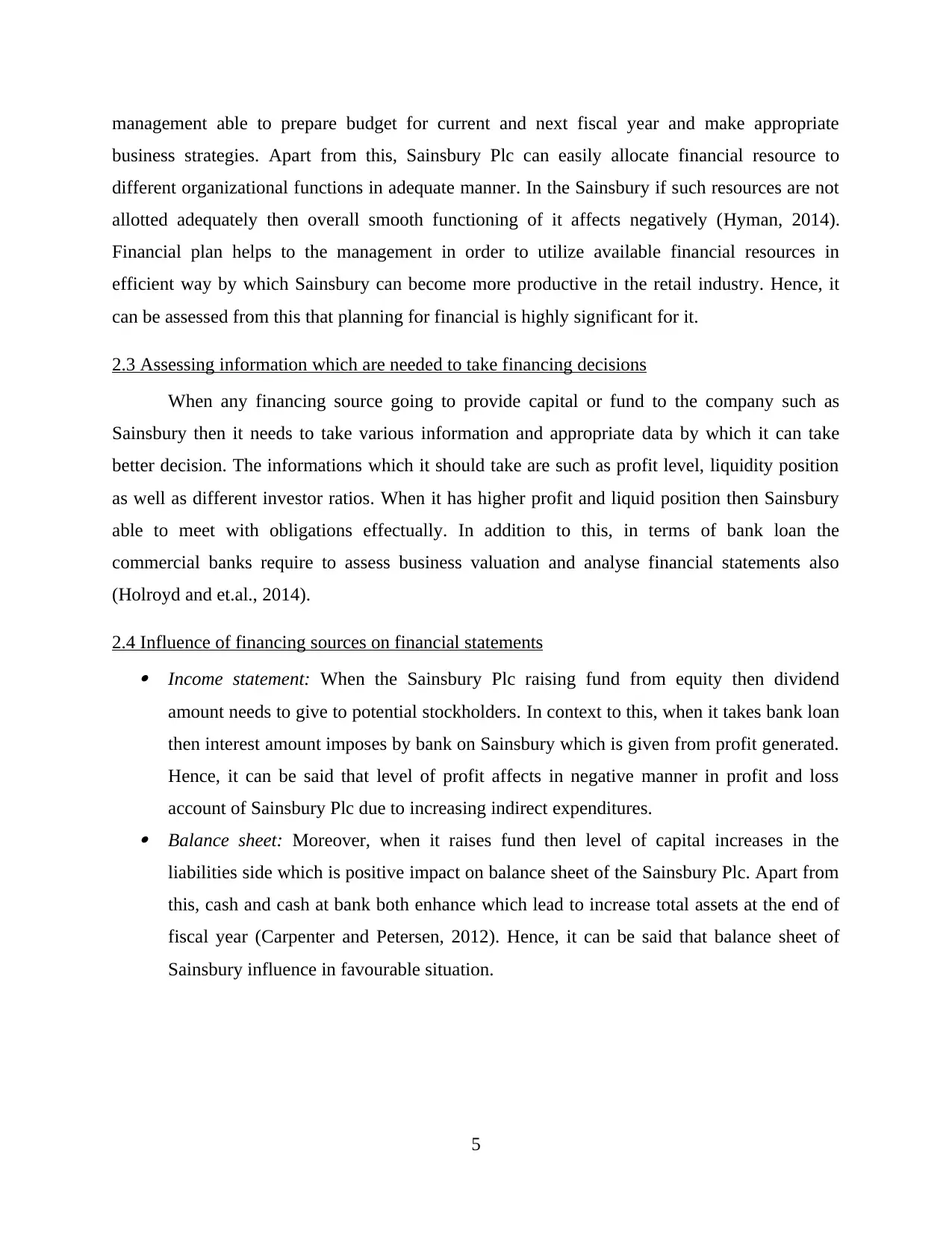
management able to prepare budget for current and next fiscal year and make appropriate
business strategies. Apart from this, Sainsbury Plc can easily allocate financial resource to
different organizational functions in adequate manner. In the Sainsbury if such resources are not
allotted adequately then overall smooth functioning of it affects negatively (Hyman, 2014).
Financial plan helps to the management in order to utilize available financial resources in
efficient way by which Sainsbury can become more productive in the retail industry. Hence, it
can be assessed from this that planning for financial is highly significant for it.
2.3 Assessing information which are needed to take financing decisions
When any financing source going to provide capital or fund to the company such as
Sainsbury then it needs to take various information and appropriate data by which it can take
better decision. The informations which it should take are such as profit level, liquidity position
as well as different investor ratios. When it has higher profit and liquid position then Sainsbury
able to meet with obligations effectually. In addition to this, in terms of bank loan the
commercial banks require to assess business valuation and analyse financial statements also
(Holroyd and et.al., 2014).
2.4 Influence of financing sources on financial statements Income statement: When the Sainsbury Plc raising fund from equity then dividend
amount needs to give to potential stockholders. In context to this, when it takes bank loan
then interest amount imposes by bank on Sainsbury which is given from profit generated.
Hence, it can be said that level of profit affects in negative manner in profit and loss
account of Sainsbury Plc due to increasing indirect expenditures. Balance sheet: Moreover, when it raises fund then level of capital increases in the
liabilities side which is positive impact on balance sheet of the Sainsbury Plc. Apart from
this, cash and cash at bank both enhance which lead to increase total assets at the end of
fiscal year (Carpenter and Petersen, 2012). Hence, it can be said that balance sheet of
Sainsbury influence in favourable situation.
5
business strategies. Apart from this, Sainsbury Plc can easily allocate financial resource to
different organizational functions in adequate manner. In the Sainsbury if such resources are not
allotted adequately then overall smooth functioning of it affects negatively (Hyman, 2014).
Financial plan helps to the management in order to utilize available financial resources in
efficient way by which Sainsbury can become more productive in the retail industry. Hence, it
can be assessed from this that planning for financial is highly significant for it.
2.3 Assessing information which are needed to take financing decisions
When any financing source going to provide capital or fund to the company such as
Sainsbury then it needs to take various information and appropriate data by which it can take
better decision. The informations which it should take are such as profit level, liquidity position
as well as different investor ratios. When it has higher profit and liquid position then Sainsbury
able to meet with obligations effectually. In addition to this, in terms of bank loan the
commercial banks require to assess business valuation and analyse financial statements also
(Holroyd and et.al., 2014).
2.4 Influence of financing sources on financial statements Income statement: When the Sainsbury Plc raising fund from equity then dividend
amount needs to give to potential stockholders. In context to this, when it takes bank loan
then interest amount imposes by bank on Sainsbury which is given from profit generated.
Hence, it can be said that level of profit affects in negative manner in profit and loss
account of Sainsbury Plc due to increasing indirect expenditures. Balance sheet: Moreover, when it raises fund then level of capital increases in the
liabilities side which is positive impact on balance sheet of the Sainsbury Plc. Apart from
this, cash and cash at bank both enhance which lead to increase total assets at the end of
fiscal year (Carpenter and Petersen, 2012). Hence, it can be said that balance sheet of
Sainsbury influence in favourable situation.
5
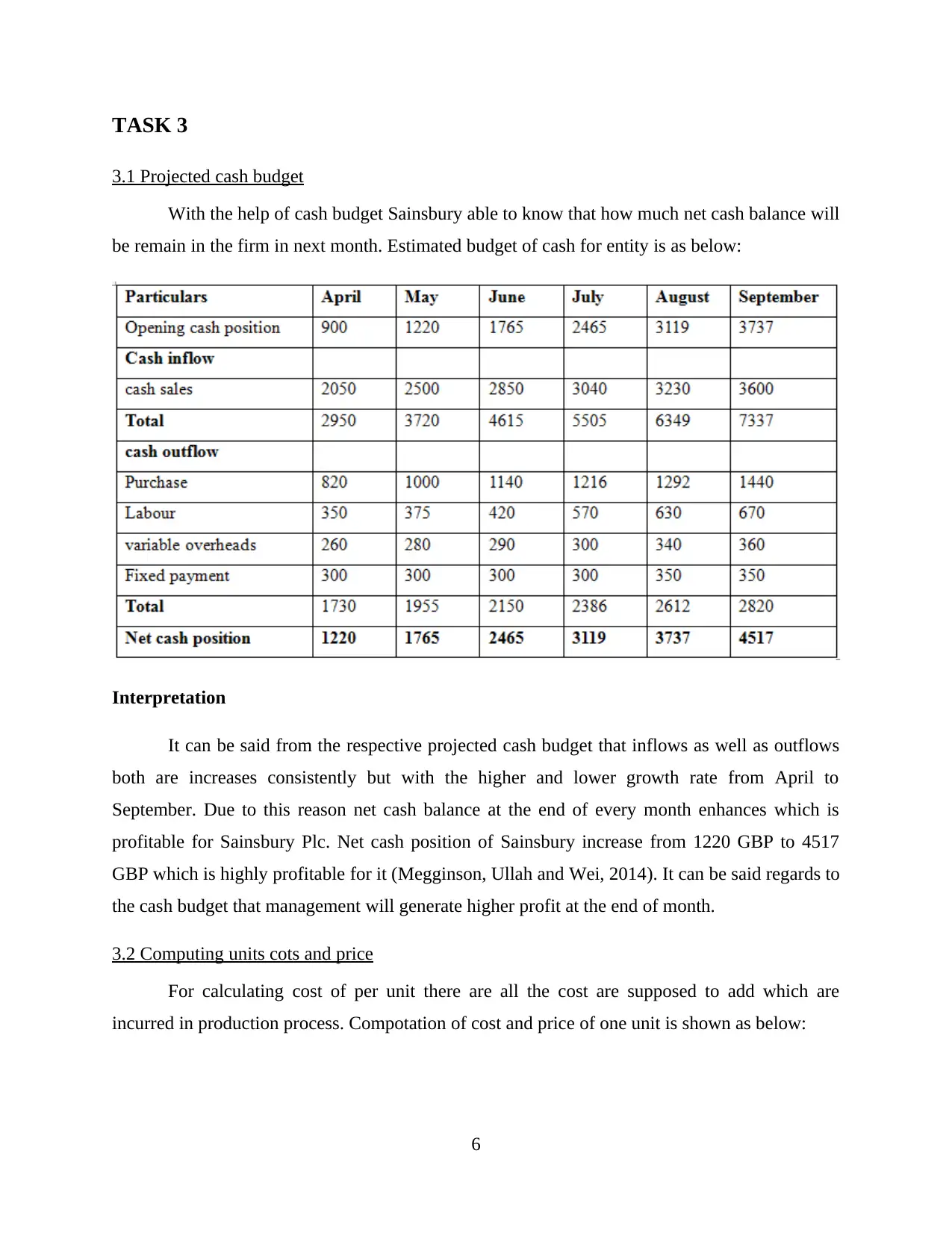
TASK 3
3.1 Projected cash budget
With the help of cash budget Sainsbury able to know that how much net cash balance will
be remain in the firm in next month. Estimated budget of cash for entity is as below:
Interpretation
It can be said from the respective projected cash budget that inflows as well as outflows
both are increases consistently but with the higher and lower growth rate from April to
September. Due to this reason net cash balance at the end of every month enhances which is
profitable for Sainsbury Plc. Net cash position of Sainsbury increase from 1220 GBP to 4517
GBP which is highly profitable for it (Megginson, Ullah and Wei, 2014). It can be said regards to
the cash budget that management will generate higher profit at the end of month.
3.2 Computing units cots and price
For calculating cost of per unit there are all the cost are supposed to add which are
incurred in production process. Compotation of cost and price of one unit is shown as below:
6
3.1 Projected cash budget
With the help of cash budget Sainsbury able to know that how much net cash balance will
be remain in the firm in next month. Estimated budget of cash for entity is as below:
Interpretation
It can be said from the respective projected cash budget that inflows as well as outflows
both are increases consistently but with the higher and lower growth rate from April to
September. Due to this reason net cash balance at the end of every month enhances which is
profitable for Sainsbury Plc. Net cash position of Sainsbury increase from 1220 GBP to 4517
GBP which is highly profitable for it (Megginson, Ullah and Wei, 2014). It can be said regards to
the cash budget that management will generate higher profit at the end of month.
3.2 Computing units cots and price
For calculating cost of per unit there are all the cost are supposed to add which are
incurred in production process. Compotation of cost and price of one unit is shown as below:
6
⊘ This is a preview!⊘
Do you want full access?
Subscribe today to unlock all pages.

Trusted by 1+ million students worldwide
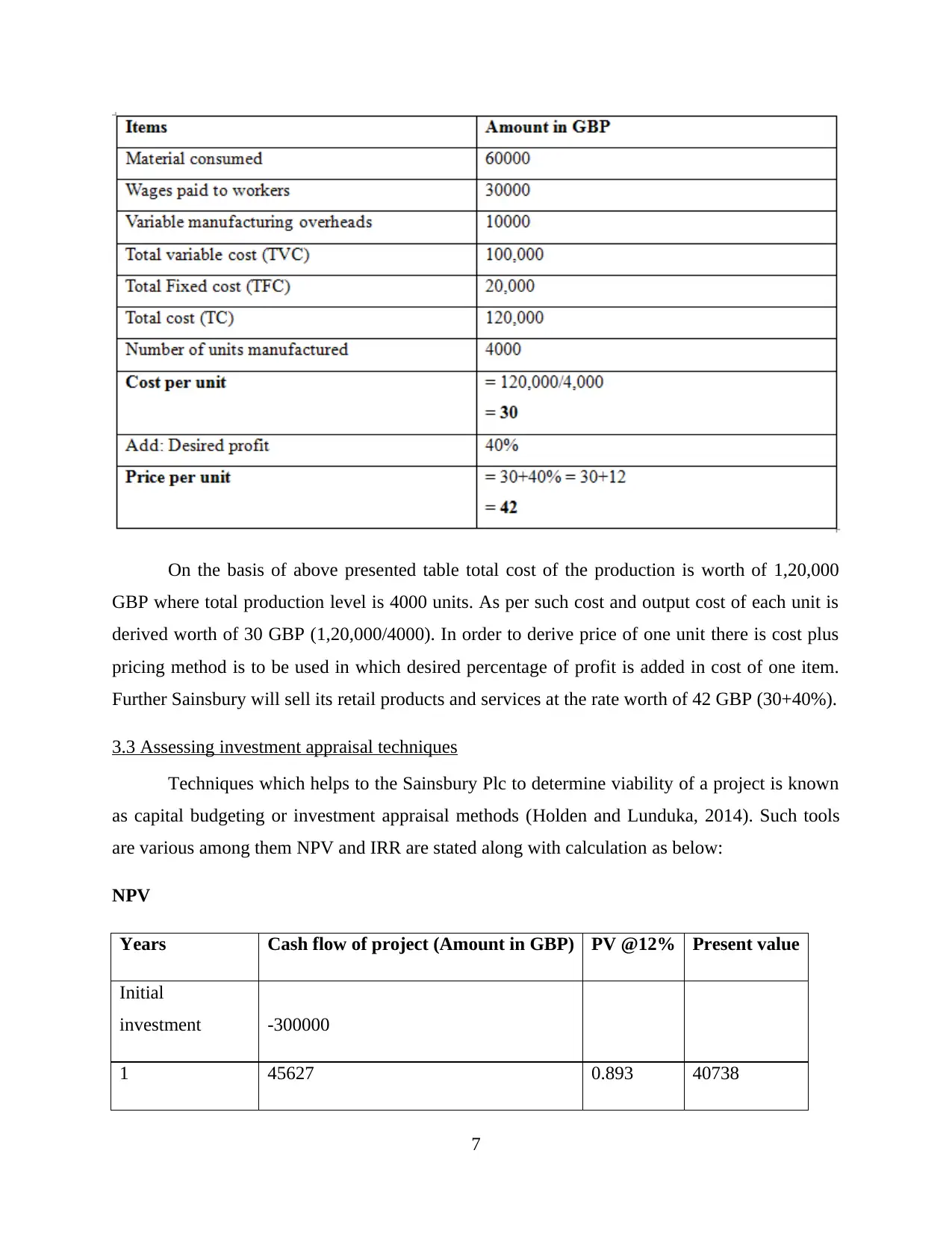
On the basis of above presented table total cost of the production is worth of 1,20,000
GBP where total production level is 4000 units. As per such cost and output cost of each unit is
derived worth of 30 GBP (1,20,000/4000). In order to derive price of one unit there is cost plus
pricing method is to be used in which desired percentage of profit is added in cost of one item.
Further Sainsbury will sell its retail products and services at the rate worth of 42 GBP (30+40%).
3.3 Assessing investment appraisal techniques
Techniques which helps to the Sainsbury Plc to determine viability of a project is known
as capital budgeting or investment appraisal methods (Holden and Lunduka, 2014). Such tools
are various among them NPV and IRR are stated along with calculation as below:
NPV
Years Cash flow of project (Amount in GBP) PV @12% Present value
Initial
investment -300000
1 45627 0.893 40738
7
GBP where total production level is 4000 units. As per such cost and output cost of each unit is
derived worth of 30 GBP (1,20,000/4000). In order to derive price of one unit there is cost plus
pricing method is to be used in which desired percentage of profit is added in cost of one item.
Further Sainsbury will sell its retail products and services at the rate worth of 42 GBP (30+40%).
3.3 Assessing investment appraisal techniques
Techniques which helps to the Sainsbury Plc to determine viability of a project is known
as capital budgeting or investment appraisal methods (Holden and Lunduka, 2014). Such tools
are various among them NPV and IRR are stated along with calculation as below:
NPV
Years Cash flow of project (Amount in GBP) PV @12% Present value
Initial
investment -300000
1 45627 0.893 40738
7
Paraphrase This Document
Need a fresh take? Get an instant paraphrase of this document with our AI Paraphraser
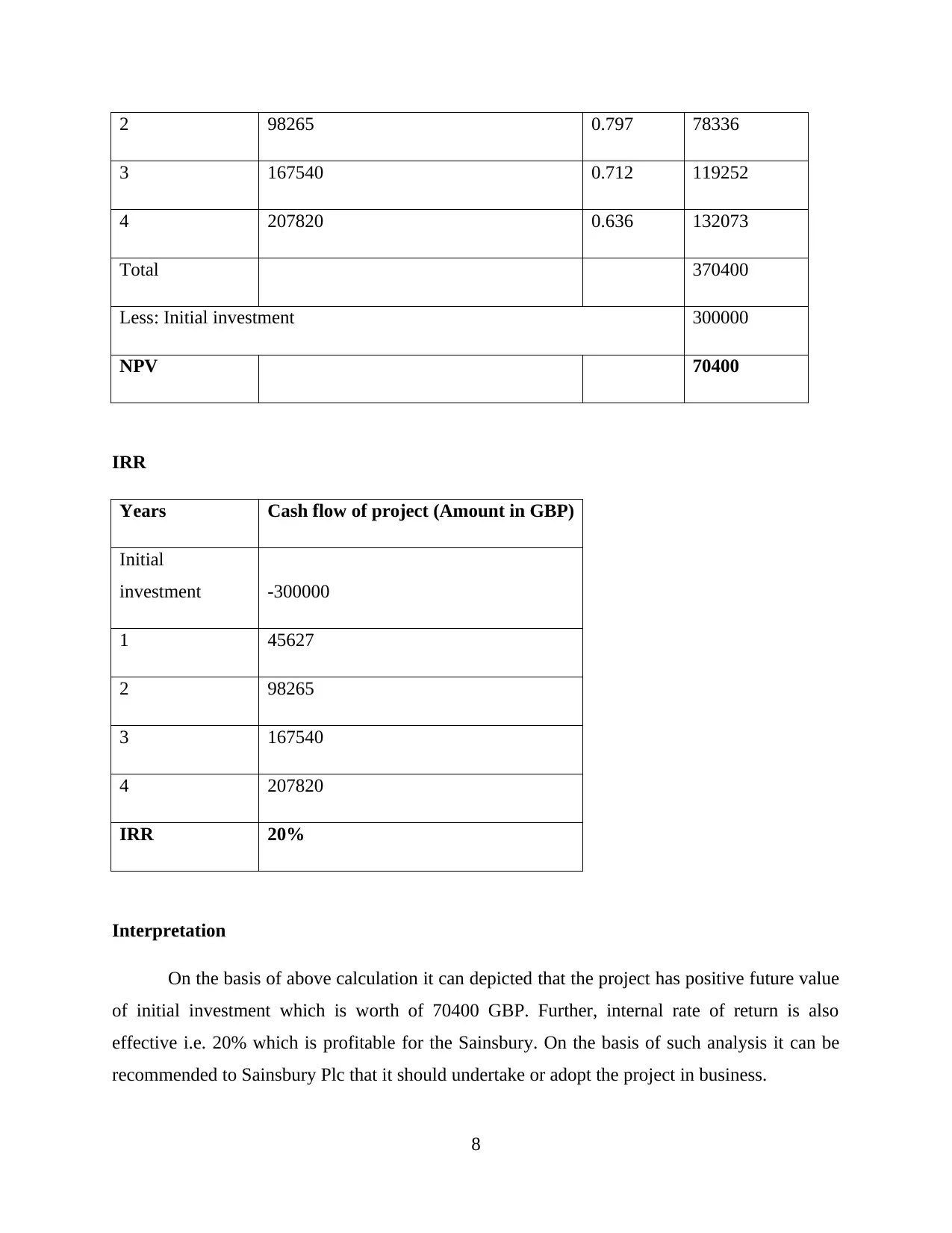
2 98265 0.797 78336
3 167540 0.712 119252
4 207820 0.636 132073
Total 370400
Less: Initial investment 300000
NPV 70400
IRR
Years Cash flow of project (Amount in GBP)
Initial
investment -300000
1 45627
2 98265
3 167540
4 207820
IRR 20%
Interpretation
On the basis of above calculation it can depicted that the project has positive future value
of initial investment which is worth of 70400 GBP. Further, internal rate of return is also
effective i.e. 20% which is profitable for the Sainsbury. On the basis of such analysis it can be
recommended to Sainsbury Plc that it should undertake or adopt the project in business.
8
3 167540 0.712 119252
4 207820 0.636 132073
Total 370400
Less: Initial investment 300000
NPV 70400
IRR
Years Cash flow of project (Amount in GBP)
Initial
investment -300000
1 45627
2 98265
3 167540
4 207820
IRR 20%
Interpretation
On the basis of above calculation it can depicted that the project has positive future value
of initial investment which is worth of 70400 GBP. Further, internal rate of return is also
effective i.e. 20% which is profitable for the Sainsbury. On the basis of such analysis it can be
recommended to Sainsbury Plc that it should undertake or adopt the project in business.
8

TASK 4
4.1 Key aspects of different financial statements
Income statement (I/S): Key purpose of such financial statement is to assess profitability
position of Sainsbury in overall retail industry. It includes different elements such as
revenue, expenditures as well as profit or loss whatever occurs.
Balance sheet (B/S): Another financial statement is balance sheet which requires for
Sainsbury in order to know liquidity position in the retail sector. Important components
of B/S are like as assets, liabilities and total equity capital of shareholder (Cox, 2014).
Cash flow statement: Purpose to prepare such statement is to analyses availability of net
cash at the end of year. In this cash flow of mainly three activities are to be include such
as investing, financing and operating.
Statement of shareholder’s equity: It helps to assess available total capital in terms of
equity which is invested by shareholders. Key aspects to such account are like as equity
capital and retained profit.
4.2 Comparison between financial statements
Basis of comparison Sainsbury Plc Sole trader
Meaning Those firms which are legally listed
in stock market and follow all the
laws and regulations of authority
body are known as limited entities.
The company which not needs to
follow any kind of regulations
and having whole ownership with
in person is identified as sole
trader.
Financial statements For the limited firm it is necessary
to prepare all the financial
statements.
For such entities not require to
prepare all financial statements
but to keep record of financial
transactions it makes income
statement and balance sheet
(Engel, Fischer and Galetovic,
2013).
Tax amount Requires to include amount of Not require to include such
9
4.1 Key aspects of different financial statements
Income statement (I/S): Key purpose of such financial statement is to assess profitability
position of Sainsbury in overall retail industry. It includes different elements such as
revenue, expenditures as well as profit or loss whatever occurs.
Balance sheet (B/S): Another financial statement is balance sheet which requires for
Sainsbury in order to know liquidity position in the retail sector. Important components
of B/S are like as assets, liabilities and total equity capital of shareholder (Cox, 2014).
Cash flow statement: Purpose to prepare such statement is to analyses availability of net
cash at the end of year. In this cash flow of mainly three activities are to be include such
as investing, financing and operating.
Statement of shareholder’s equity: It helps to assess available total capital in terms of
equity which is invested by shareholders. Key aspects to such account are like as equity
capital and retained profit.
4.2 Comparison between financial statements
Basis of comparison Sainsbury Plc Sole trader
Meaning Those firms which are legally listed
in stock market and follow all the
laws and regulations of authority
body are known as limited entities.
The company which not needs to
follow any kind of regulations
and having whole ownership with
in person is identified as sole
trader.
Financial statements For the limited firm it is necessary
to prepare all the financial
statements.
For such entities not require to
prepare all financial statements
but to keep record of financial
transactions it makes income
statement and balance sheet
(Engel, Fischer and Galetovic,
2013).
Tax amount Requires to include amount of Not require to include such
9
⊘ This is a preview!⊘
Do you want full access?
Subscribe today to unlock all pages.

Trusted by 1+ million students worldwide
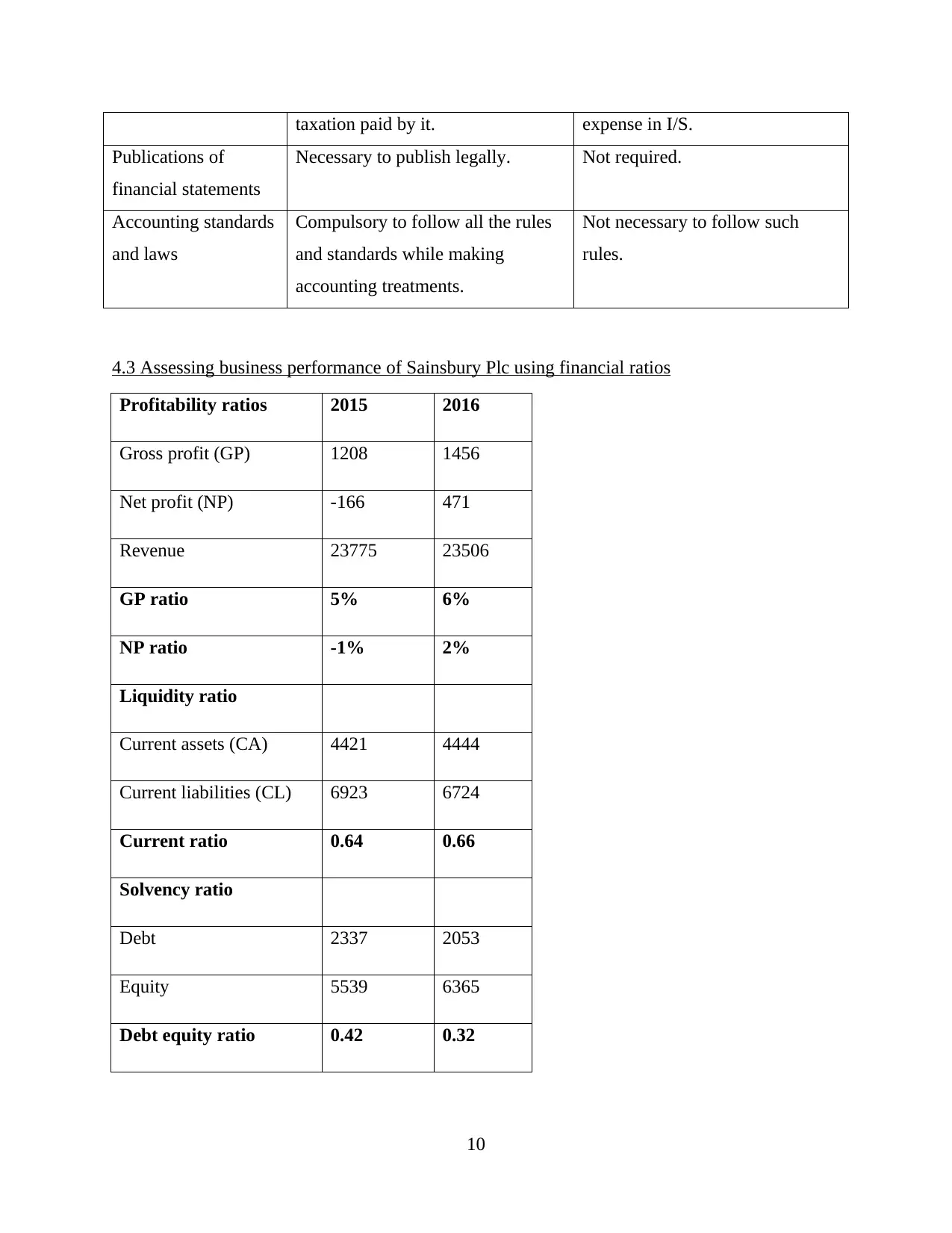
taxation paid by it. expense in I/S.
Publications of
financial statements
Necessary to publish legally. Not required.
Accounting standards
and laws
Compulsory to follow all the rules
and standards while making
accounting treatments.
Not necessary to follow such
rules.
4.3 Assessing business performance of Sainsbury Plc using financial ratios
Profitability ratios 2015 2016
Gross profit (GP) 1208 1456
Net profit (NP) -166 471
Revenue 23775 23506
GP ratio 5% 6%
NP ratio -1% 2%
Liquidity ratio
Current assets (CA) 4421 4444
Current liabilities (CL) 6923 6724
Current ratio 0.64 0.66
Solvency ratio
Debt 2337 2053
Equity 5539 6365
Debt equity ratio 0.42 0.32
10
Publications of
financial statements
Necessary to publish legally. Not required.
Accounting standards
and laws
Compulsory to follow all the rules
and standards while making
accounting treatments.
Not necessary to follow such
rules.
4.3 Assessing business performance of Sainsbury Plc using financial ratios
Profitability ratios 2015 2016
Gross profit (GP) 1208 1456
Net profit (NP) -166 471
Revenue 23775 23506
GP ratio 5% 6%
NP ratio -1% 2%
Liquidity ratio
Current assets (CA) 4421 4444
Current liabilities (CL) 6923 6724
Current ratio 0.64 0.66
Solvency ratio
Debt 2337 2053
Equity 5539 6365
Debt equity ratio 0.42 0.32
10
Paraphrase This Document
Need a fresh take? Get an instant paraphrase of this document with our AI Paraphraser
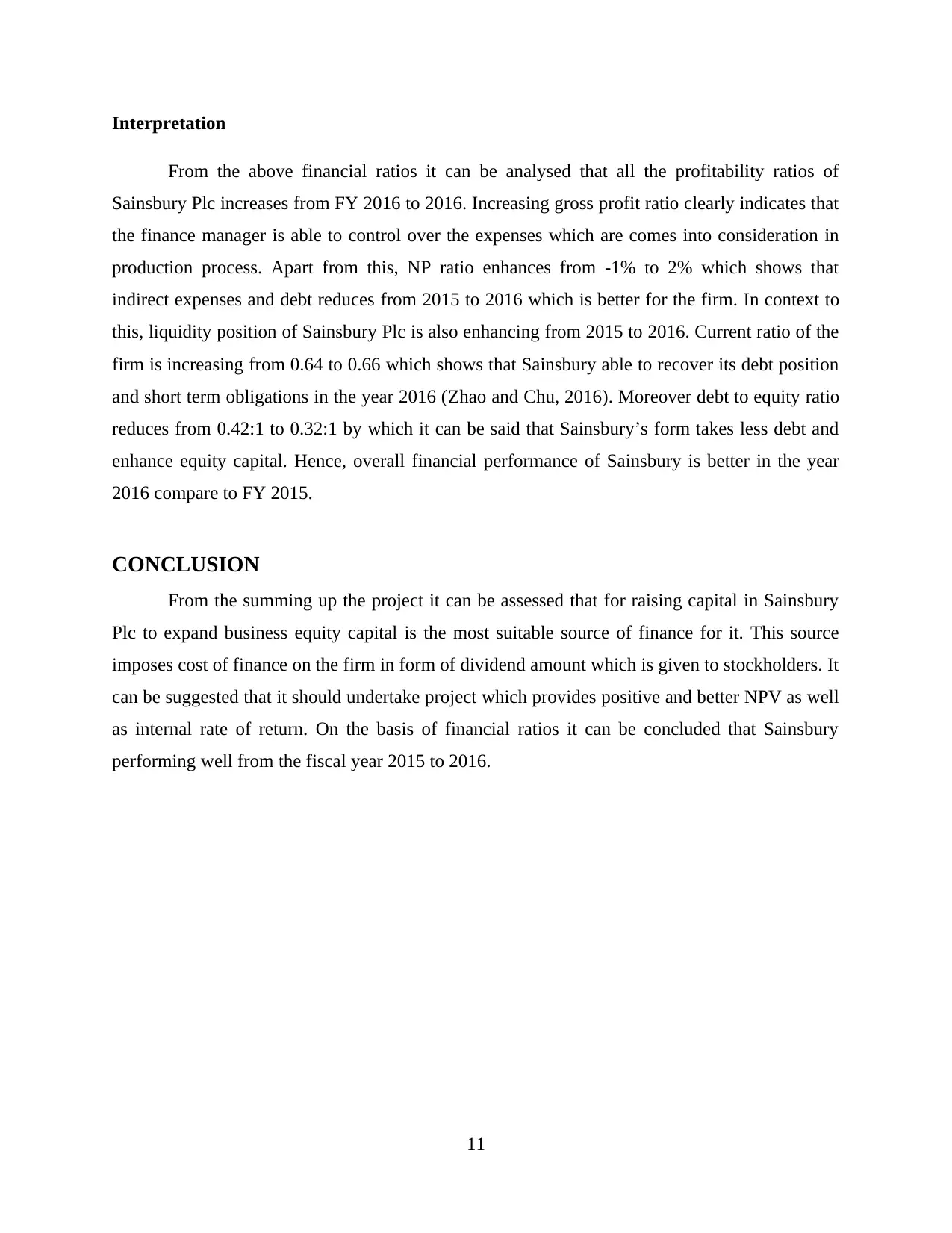
Interpretation
From the above financial ratios it can be analysed that all the profitability ratios of
Sainsbury Plc increases from FY 2016 to 2016. Increasing gross profit ratio clearly indicates that
the finance manager is able to control over the expenses which are comes into consideration in
production process. Apart from this, NP ratio enhances from -1% to 2% which shows that
indirect expenses and debt reduces from 2015 to 2016 which is better for the firm. In context to
this, liquidity position of Sainsbury Plc is also enhancing from 2015 to 2016. Current ratio of the
firm is increasing from 0.64 to 0.66 which shows that Sainsbury able to recover its debt position
and short term obligations in the year 2016 (Zhao and Chu, 2016). Moreover debt to equity ratio
reduces from 0.42:1 to 0.32:1 by which it can be said that Sainsbury’s form takes less debt and
enhance equity capital. Hence, overall financial performance of Sainsbury is better in the year
2016 compare to FY 2015.
CONCLUSION
From the summing up the project it can be assessed that for raising capital in Sainsbury
Plc to expand business equity capital is the most suitable source of finance for it. This source
imposes cost of finance on the firm in form of dividend amount which is given to stockholders. It
can be suggested that it should undertake project which provides positive and better NPV as well
as internal rate of return. On the basis of financial ratios it can be concluded that Sainsbury
performing well from the fiscal year 2015 to 2016.
11
From the above financial ratios it can be analysed that all the profitability ratios of
Sainsbury Plc increases from FY 2016 to 2016. Increasing gross profit ratio clearly indicates that
the finance manager is able to control over the expenses which are comes into consideration in
production process. Apart from this, NP ratio enhances from -1% to 2% which shows that
indirect expenses and debt reduces from 2015 to 2016 which is better for the firm. In context to
this, liquidity position of Sainsbury Plc is also enhancing from 2015 to 2016. Current ratio of the
firm is increasing from 0.64 to 0.66 which shows that Sainsbury able to recover its debt position
and short term obligations in the year 2016 (Zhao and Chu, 2016). Moreover debt to equity ratio
reduces from 0.42:1 to 0.32:1 by which it can be said that Sainsbury’s form takes less debt and
enhance equity capital. Hence, overall financial performance of Sainsbury is better in the year
2016 compare to FY 2015.
CONCLUSION
From the summing up the project it can be assessed that for raising capital in Sainsbury
Plc to expand business equity capital is the most suitable source of finance for it. This source
imposes cost of finance on the firm in form of dividend amount which is given to stockholders. It
can be suggested that it should undertake project which provides positive and better NPV as well
as internal rate of return. On the basis of financial ratios it can be concluded that Sainsbury
performing well from the fiscal year 2015 to 2016.
11
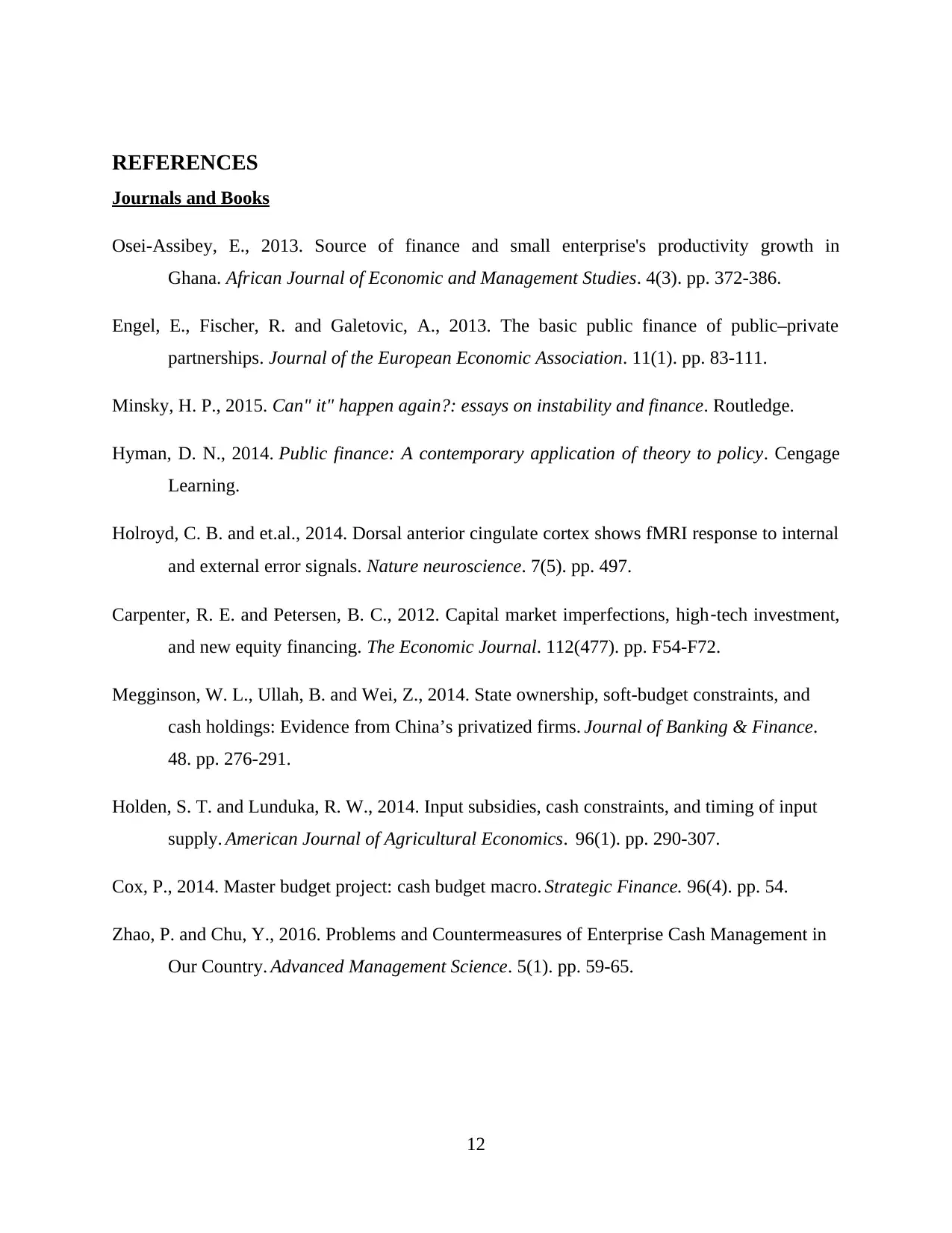
REFERENCES
Journals and Books
Osei-Assibey, E., 2013. Source of finance and small enterprise's productivity growth in
Ghana. African Journal of Economic and Management Studies. 4(3). pp. 372-386.
Engel, E., Fischer, R. and Galetovic, A., 2013. The basic public finance of public–private
partnerships. Journal of the European Economic Association. 11(1). pp. 83-111.
Minsky, H. P., 2015. Can" it" happen again?: essays on instability and finance. Routledge.
Hyman, D. N., 2014. Public finance: A contemporary application of theory to policy. Cengage
Learning.
Holroyd, C. B. and et.al., 2014. Dorsal anterior cingulate cortex shows fMRI response to internal
and external error signals. Nature neuroscience. 7(5). pp. 497.
Carpenter, R. E. and Petersen, B. C., 2012. Capital market imperfections, high‐tech investment,
and new equity financing. The Economic Journal. 112(477). pp. F54-F72.
Megginson, W. L., Ullah, B. and Wei, Z., 2014. State ownership, soft-budget constraints, and
cash holdings: Evidence from China’s privatized firms. Journal of Banking & Finance.
48. pp. 276-291.
Holden, S. T. and Lunduka, R. W., 2014. Input subsidies, cash constraints, and timing of input
supply. American Journal of Agricultural Economics. 96(1). pp. 290-307.
Cox, P., 2014. Master budget project: cash budget macro. Strategic Finance. 96(4). pp. 54.
Zhao, P. and Chu, Y., 2016. Problems and Countermeasures of Enterprise Cash Management in
Our Country. Advanced Management Science. 5(1). pp. 59-65.
12
Journals and Books
Osei-Assibey, E., 2013. Source of finance and small enterprise's productivity growth in
Ghana. African Journal of Economic and Management Studies. 4(3). pp. 372-386.
Engel, E., Fischer, R. and Galetovic, A., 2013. The basic public finance of public–private
partnerships. Journal of the European Economic Association. 11(1). pp. 83-111.
Minsky, H. P., 2015. Can" it" happen again?: essays on instability and finance. Routledge.
Hyman, D. N., 2014. Public finance: A contemporary application of theory to policy. Cengage
Learning.
Holroyd, C. B. and et.al., 2014. Dorsal anterior cingulate cortex shows fMRI response to internal
and external error signals. Nature neuroscience. 7(5). pp. 497.
Carpenter, R. E. and Petersen, B. C., 2012. Capital market imperfections, high‐tech investment,
and new equity financing. The Economic Journal. 112(477). pp. F54-F72.
Megginson, W. L., Ullah, B. and Wei, Z., 2014. State ownership, soft-budget constraints, and
cash holdings: Evidence from China’s privatized firms. Journal of Banking & Finance.
48. pp. 276-291.
Holden, S. T. and Lunduka, R. W., 2014. Input subsidies, cash constraints, and timing of input
supply. American Journal of Agricultural Economics. 96(1). pp. 290-307.
Cox, P., 2014. Master budget project: cash budget macro. Strategic Finance. 96(4). pp. 54.
Zhao, P. and Chu, Y., 2016. Problems and Countermeasures of Enterprise Cash Management in
Our Country. Advanced Management Science. 5(1). pp. 59-65.
12
⊘ This is a preview!⊘
Do you want full access?
Subscribe today to unlock all pages.

Trusted by 1+ million students worldwide
1 out of 12
Related Documents
Your All-in-One AI-Powered Toolkit for Academic Success.
+13062052269
info@desklib.com
Available 24*7 on WhatsApp / Email
![[object Object]](/_next/static/media/star-bottom.7253800d.svg)
Unlock your academic potential
Copyright © 2020–2025 A2Z Services. All Rights Reserved. Developed and managed by ZUCOL.




